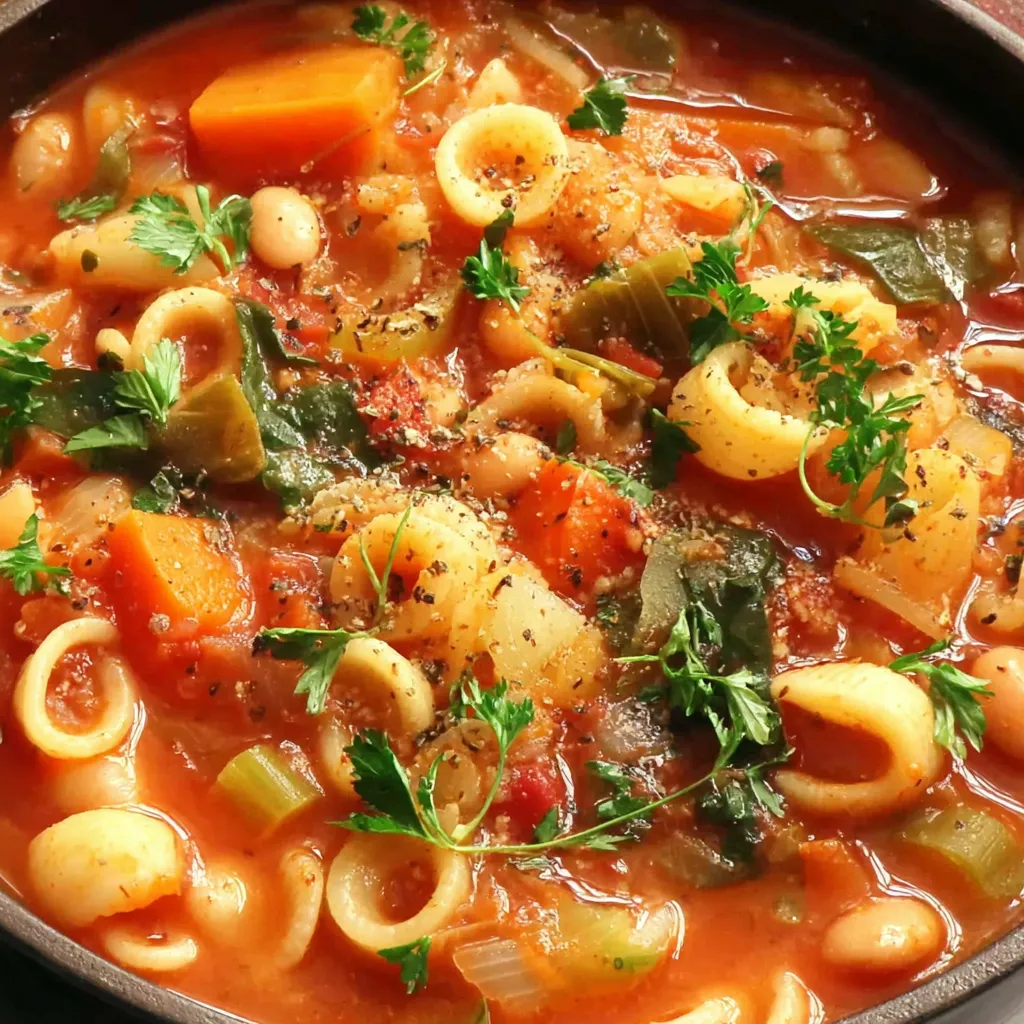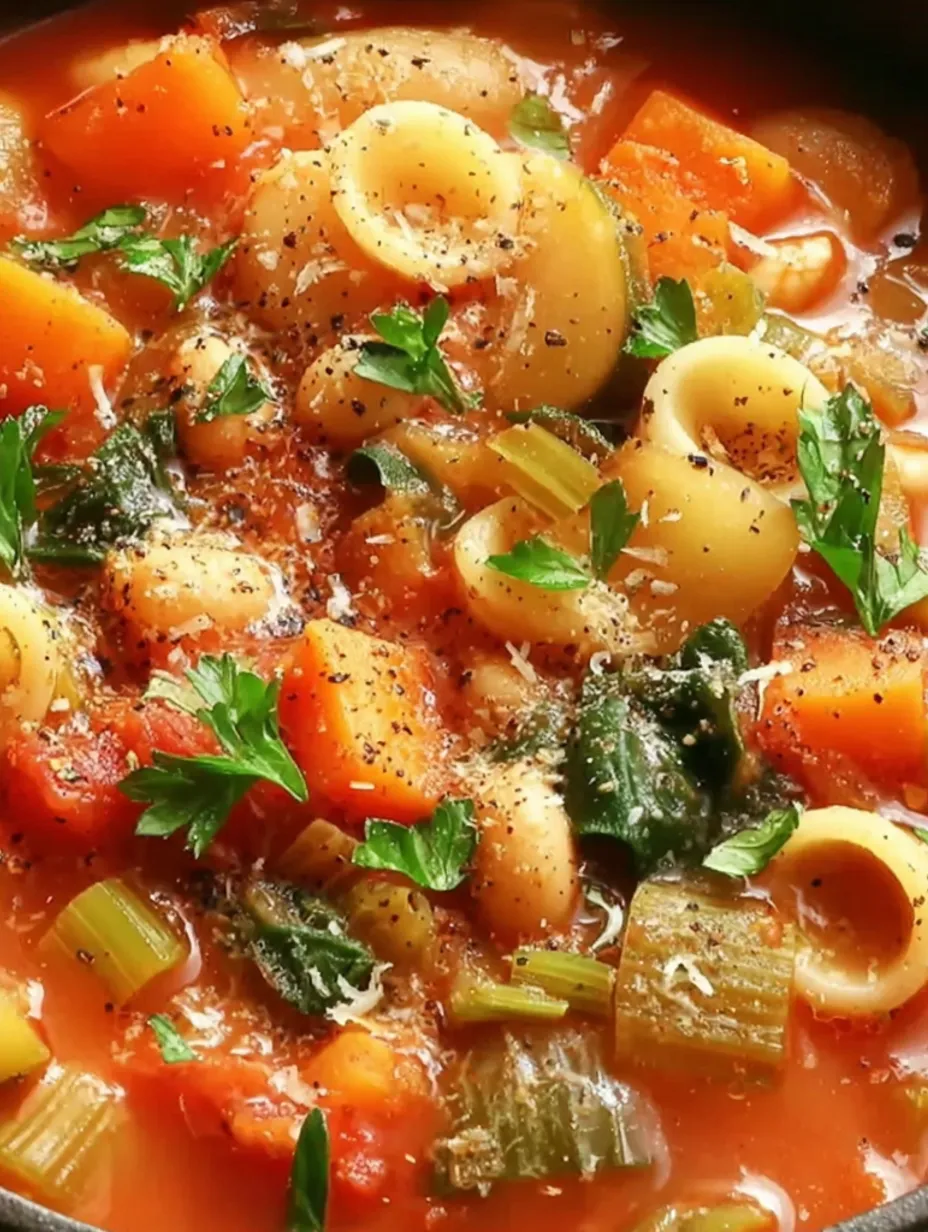 Bookmark
Bookmark
This comforting minestrone brings together a medley of vegetables, hearty beans, and pasta in a flavorful herb-infused broth. It is the kind of dish that warms you through on a cool evening and is versatile enough to adapt with whatever seasonal produce you have on hand.
I first made this after a day of baking Christmas cookies, wanting something savory and nourishing to balance the sweetness. Since then, it has become a winter favorite.
Ingredients
- Extra-virgin olive oil: adds richness and helps sauté vegetables evenly
- Yellow onion: brings sweetness and depth when cooked slowly
- Carrots: add color and a subtle earthy sweetness
- Celery: offers aromatic flavor and structure
- Sea salt: enhances natural flavors
- Black pepper: adds gentle spice
- Garlic: gives robust aromatic depth when added after the base vegetables
- Diced tomatoes: provide acidity and a rich tomato flavor
- Cooked white or kidney beans: contribute protein and creamy texture
- Green beans: add vibrant color and fresh crunch
- Vegetable broth: forms the savory base of the soup
- Bay leaves: impart subtle herbal fragrance during simmering
- Dried oregano: lends Mediterranean flavor
- Dried thyme: adds gentle earthy notes
- Small pasta such as elbows or shells: creates heartiness and absorbs broth flavor
- Fresh parsley: gives freshness to the finished soup
- Red pepper flakes: provide optional heat
- Grated Parmesan cheese: adds a final savory touch if desired
Step-by-Step Instructions
- Sauté the Aromatics:
- Cook olive oil, diced onion, carrots, celery, sea salt, and black pepper in a large pot over medium heat for about eight minutes until softened and fragrant. This builds the base flavor.
- Simmer the Soup Base:
- Add grated garlic, diced tomatoes, cooked beans, green beans, vegetable broth, bay leaves, oregano, and thyme. Cover and simmer gently for twenty minutes to allow flavors to meld.
- Cook the Pasta:
- Stir in the small pasta and cook uncovered for about ten minutes until tender, allowing starch to enrich the broth.
- Season and Serve:
- Taste and adjust seasoning as needed. Ladle into bowls and top with parsley, red pepper flakes, and Parmesan if desired. Serve hot with crusty bread.
 Bookmark
Bookmark
I especially love the addition of fresh parsley at the end. It brightens the whole dish and reminds me of my grandmother’s kitchen garden where she grew herbs right outside the back door.
Storage Tips
Store leftovers in the refrigerator for up to four days. For best results, keep pasta separate and add before reheating to maintain texture.
Ingredient Substitutions
Replace green beans with zucchini, yellow squash, or a mix of both. Swap small pasta for quick-cooking grains such as farro or barley for a different texture. Use fresh Roma tomatoes in summer for a brighter flavor.
Serving Suggestions
Pair with crusty bread for a simple meal. Add a crisp side salad such as arugula, beet, or pear salad for balance. Garnish with pesto for an herby twist.
 Bookmark
Bookmark
Cultural Context
Minestrone is a traditional Italian soup known for its adaptability and use of seasonal vegetables. Its name comes from the Italian word minestra meaning soup, and it has been a staple across Italian regions for centuries.
Frequently Asked Questions About Recipes
- → Can I use different beans?
Yes! Feel free to swap in navy beans, cannellini beans, or red kidney beans based on your preference or availability.
- → How can I make this soup gluten-free?
To make this soup gluten-free, simply replace the pasta with a gluten-free variety, such as rice or gluten-free pasta.
- → Can I freeze minestrone soup?
Yes, minestrone soup freezes well. Just make sure to cook the pasta separately if you plan to freeze it, as it may become mushy when reheated.
- → Can I make this soup vegan?
Absolutely! You can skip the Parmesan cheese or use a vegan cheese alternative for a fully vegan version.
- → How long will this soup last in the fridge?
This soup keeps well for up to 4 days in the fridge. For best results, store the pasta separately if possible to prevent it from absorbing too much broth.
